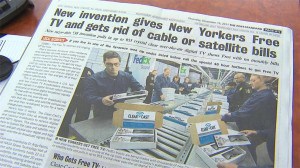
An ad in the Syracuse Post-Standard announces a new invention -- a bow tie antenna design originally designed in the 1950s.
Back in December, Stop the Cap! alerted readers about the “revolutionary razor thin” HDTV antenna Clear-Cast that promised salvation from high cable and satellite TV bills forever. No article published here has attracted as much attention as that one, drawing more than 40,000 new readers to find out whether the product is truly a scientific breakthrough, or razor thin hype.
Readers have overwhelmingly agreed with our review of the product — it did no better than a $1.49 antenna we bought years earlier from Radio Shack. But plenty of readers also shared their disappointment with the company advertising Clear-Cast: Canton, Ohio-based Universal Media Syndicate, Inc.
The Canton Regional and Greater West Virginia Better Business Bureau reports it has received “numerous” complaints about Clear-Cast’s marketing practices, refund policies, and advertising claims. Indeed, we’ve heard from hundreds of readers who assumed we sold the product, and a lot of choice words were included in the angergram e-mails mistakenly sent our way. Among the claims many found deceptive — Clear-Cast’s marketing stretch that users can receive up to 953 shows (not channels).
Our story has been linked from a number of other websites, so many in fact our review of the product often appears higher in Google’s search rankings than the company selling the product itself.
Clear-Cast’s advertising, designed to look like an authentic newspaper article, has appeared in dozens of newspapers around the country. Many readers report the price has increased as well, now selling for as much as $50, not including the high-pressure sales tactics to throw in “warranty protection” ($5 buys you two years) and shipping and handling (add another $10). We found readers who spent $110 for two bow-tie antennas that used to be included with televisions until the 1980s for free.
Our findings: Clear-Cast is an antenna capable of receiving local broadcast channels, but no better or worse than other basic antennas we have tested that sell for $4-9.
Returning the product for a refund also proved nightmarish. We received a working antenna from one of our readers if we’d agree to return to it the company when we were finished. It was returned by Priority Mail in late January and was received by them in two business days. Our reader reports a credit for the return finally posted to his credit card statement this morning — nearly four months later.
The BBB received such a substantial number of complaints, they met with the company in January to discuss their product and how it is sold:
The BBB found that the product does provide channels without cable or satellite. However BBB inquiries indicate that because the headline states that you can get rid of cable or satellite bills, consumers are under the impression that they will receive the same type of channeling as they would with their current provider.
Additionally, there seems to be some confusion as to what is actually being given away for free. In the company ad it states in the headline “Free TV” and “gets rid of cable or satellite bills.” Some inquiries indicate that consumers are under the impression that they will be receiving a free television. Also there seems to be confusion as to how many possible channels a consumer may get when using the ClearCast Digital HDTV. The company ad has indicated that consumers can receive up to 953 “Shows” and up to 53 “channels” depending on where you live.
The company has added disclosures that outline and explain what the consumers are actually getting, however the overall impression of the ad seems to imply differently.
The basic principles of the BBB code of advertisement states that an advertisement as a whole may be misleading although every sentence separately considered is literally true. Consumers are encouraged to read the ad in its entirety and despite deadlines and restrictions, to make sure the company and product is researched prior to purchase in order to make an educated buying decision.
We were not surprised to learn readers were still complaining about Clear-Cast as late as this weekend.
Universal Media Syndicate, which is responsible for its marketing, also pitches:
- the so-called “Amish-Made” Heat Surge Fireplace (all parts from China, with only the wood frame made by “Amish” employees);
- “three hundred ninety-eight dollars and shipping”-portable air conditioner ArcticPro;
- coin peddler World Reserve Monetary Exchange;
- PatentHEALTH, a Canton-based provider of something called “nutraceuticals” that include an FDA warning suggesting their products are “not intended to diagnose, treat, cure or prevent disease.”
Our advice for cord cutters remains the same:
Antenna design really has not changed much in 50 years. Here is a good and credible site to explore: http://www.antennaweb.org/Info/AntennaInfo.aspx
Start out with something basic. The best antennas allow you to orient them in different directions towards the signal you want. For UHF, try a set top loop-style antenna that can be rotated (Wal-Mart probably has one). You might also find playing around with some aluminum foil attached behind the antenna or even to it can make some difference. Experiment… a lot, until you find the ideal position for your antenna. If you are thinking of spending $38 on Clear Cast, remember it will probably cost you at least $5 to mail it back if you find it not worth keeping.
For the absolute best results, seriously consider a traditional outdoor or attic antenna. Channel Master and Winegard are quality manufacturers with a long history. They sell online and UPS can deliver it straight to your home already assembled in many cases.
But always hire a professional installer if you are absolutely not certain of your rooftop skills. A frequent cause of rooftop falls and other accidents used to be attributed to do-it-yourself antenna installers who didn’t appreciate the risks.
[flv width=”360″ height=”290″]http://www.phillipdampier.com/video/WTVQ Lexington Clear-Cast HDTV Antenna 3-28-12.mp4[/flv]
WTVQ in Lexington, Kentucky investigated viewer complaints about Clear-Cast and talked with the Better Business Bureau about the company and its marketing tactics. (3 minutes)


 Subscribe
Subscribe









